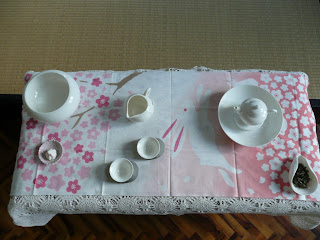
All puerh lovers sooner or later think how to conserve it so that its distinctive aroma and its great value (especially for cakes already quite aged) do not stray.
The conditions for the aging puerh and the correct conservation are to keep it in an environment free of odors, ventilated and with a constant temperature around 22/25 C° and with a very high humidity (between 75 and 80 %).
These conditions, here in Italy (and in Europe in general) are not common then the only solution we have it's to create a "pumidor": a humidifier for puerh.
My pumidor is very 'homely' but for the moment it works.
I chose an unpainted wood trunk that close well and has no holes. With the drill I made a little hole in the left side to the wires of the fan.
I fixed inside a hygrometer (humidity and temperature controls) and a small fan connected to the power (a cigars model). Then I put a small cigars humidor, but I realized early that it was inadequate for a trunk so big and I decided to reinforce the moisture by adding a container with three natural sponges that soak every day of purified water.
No need to keep a container of water inside because it does not evaporate, it takes necessarily sponges soaked. The important thing in these cases is to remember to wash the sponges every day to avoid the bacteria proliferate. Using purified water is not formed limestone that may obstruct the porosity of the sponge. Alternatively you can use a real home humidifier for those environments. For temperature I solved by putting the trunk in proximity of a radiator.
And here's the inside of my home pumidor.

Here, instead, a panoramic of my personal puerh collection...




























